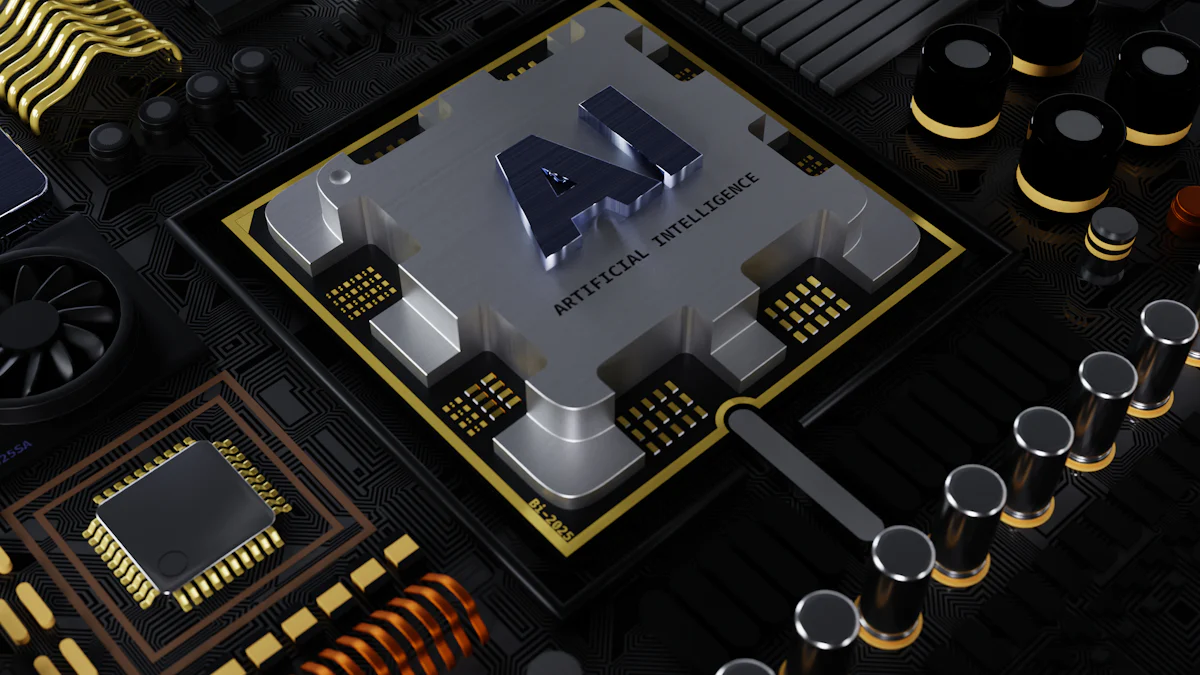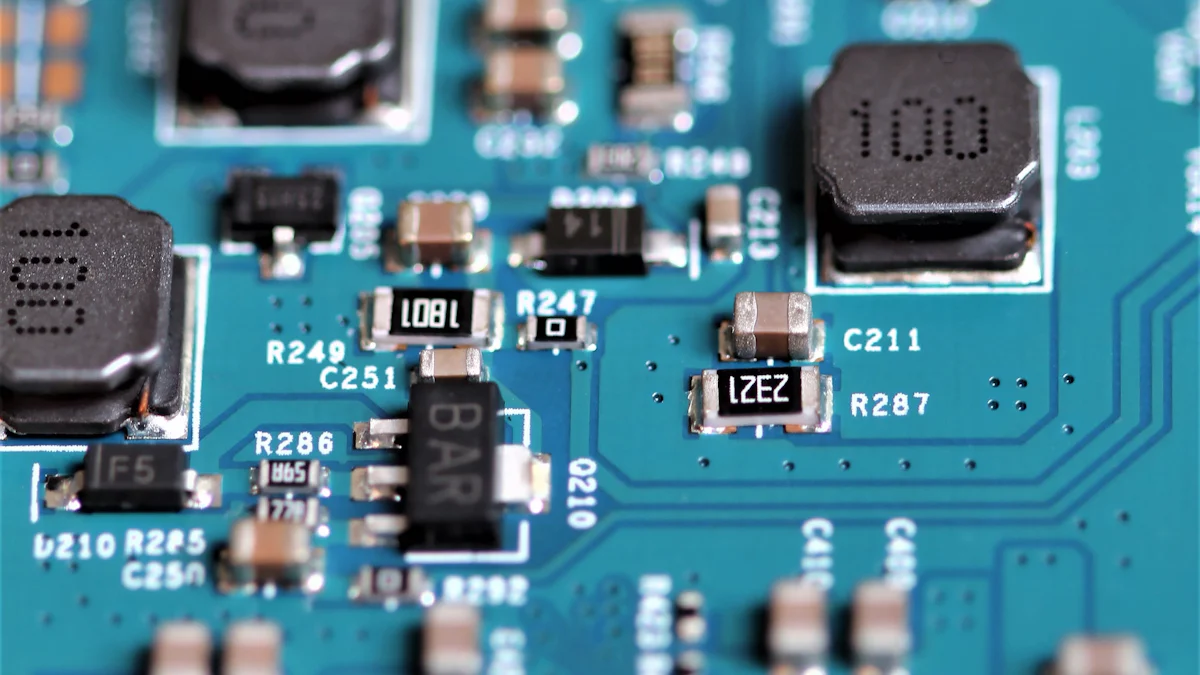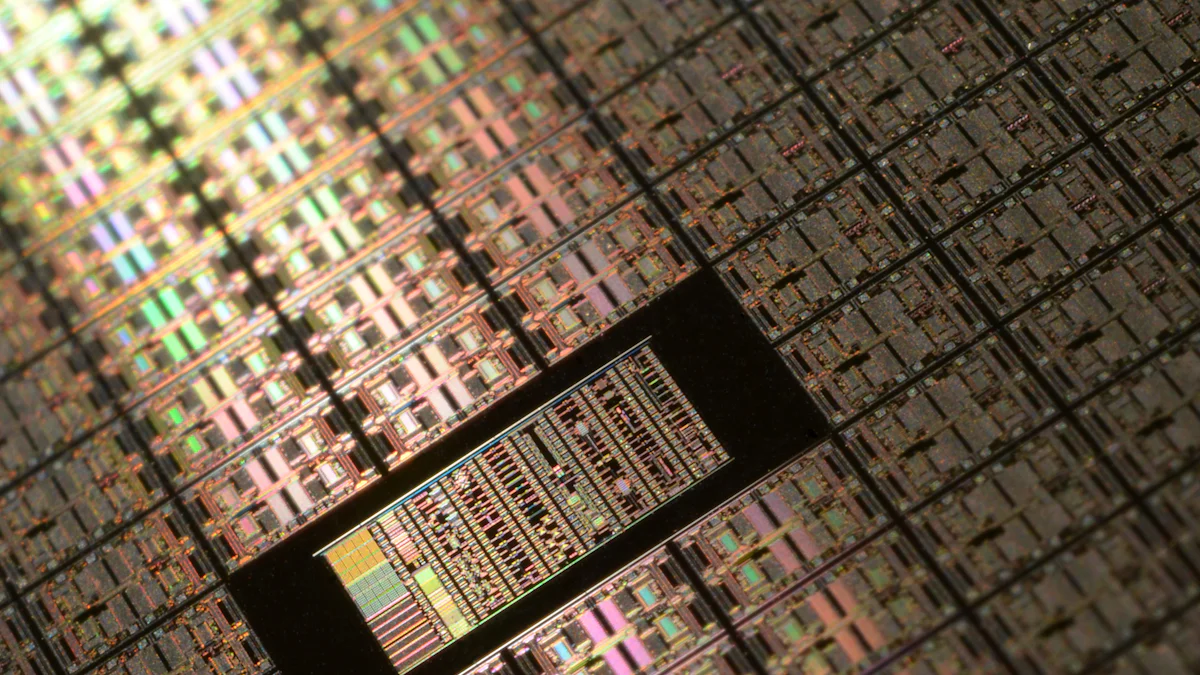
半導体製造における精密・信頼性を確保し、エピタキシャル蒸着プロセスにおいて欠かせない部品として、Sie Epi susceptors は不可欠です。 熱処理中のウェーハをサポートし、エピタキシャル成長のための安定した環境を作り出します。 炭化ケイ素でコーティングされた高純度のグラファイトのような材料を利用することで、抜群の耐熱性と均一な熱分布を実現します。 設計は、汚染を防ぎ、プロセス安定性を維持します。これは、高品質の半導体デバイスを製造するために不可欠です。 高度な電子機器の需要が高まるにつれて、si のエピの受容体は、産業の厳格な要件を満たし、効率とパフォーマンスのための重要な役割を果たしています.
要点
Si Epiのスセプターは必須です エピタキシャルの沈着プロセスの間に精密な熱条件を維持するために、良質の半導体装置を保障します.
- 高純度のグラファイトから構成され、炭化ケイ素でコーティングされた、これらのスセプターは熱分解への例外的な耐久性そして抵抗を提供します.
- 高度な設計により、熱グラデーションを最小化し、均一な熱分布を促進し、半導体ウェーハの欠陥率を削減します.
- スマートスセプターシステムにおけるセンサーの統合により、リアルタイム監視、プロセスの信頼性と効率性の向上を実現します.
- 半導体技術は、より小さなノードに進むため、Si Epi Susceptorsは、高性能チップに必要な精度を実現する上で重要な役割を果たしています.
- Si Epiのスセプターを利用することで、ウェーハの品質を改善し、製造ワークフローのメンテナンスニーズを軽減することで、コストを大幅に削減できます.
サステナビリティの強化 半導体製造におけるエネルギー効率を最適化し、環境影響を最小限に抑えるSiC-coated susceptorsの使用による.
Si Epiのスセプターの理解

Si Epiのスセプターは何ですか?
Si Epiのスセプターの定義そして設計原則.
Si の Epi の susceptors は熱処置の間にウエファーを支えるように設計されている表軸の沈殿物プロセスの重要なコンポーネントです。 これらのツールは、半導体デバイス製造に不可欠であるエピタキシャル層の成長のための制御された環境を保証します。 設計は熱安定性、均一熱配分および粗い処理条件への抵抗を優先します。 メーカーは、これらのスセプターを精密なジオメトリで設計し、高度な半導体アプリケーションでのパフォーマンスを最適化します.
グラファイトおよび炭化ケイ素のコーティングのような使用される共通の材料.
Si の Epi の感受性器の構造は極度な温度および化学露出に耐えることができる材料に頼ります。 高い純度のグラファイトは優秀な熱伝導性および構造の完全性による共通の基礎材料として役立ちます。 耐久性と性能を向上させるために、メーカーは炭化ケイ素(SiC)でグラファイトをコーティングします。 熱分解および化学腐食への優秀な抵抗を提供します。 プロダクトのような VeTekセミコンダクターのEPIの感受性 そして、 シリコンカーバイド(SiC)ウェーハスセプター 均一な熱プロフィールを維持し、エピタキシャル成長中の汚染を防ぐSiCコーティングの有効性を実証します.
Si Epi Susceptors関数はどのように機能しますか?
エピタキシャル蒸着および熱処理の彼らの役割.
Si の Epi の susceptors はウエファーを安全に握り、一貫した熱条件を保障することによってエピタキシャルの沈殿物の pivotal 役割をします。 プロセス中、熱を効率的に吸収し、転送し、高品質のエピタキシャル層の形成に理想的な環境を作成します。 半導体デバイスにおける望ましい電気的特性を達成するために、この精度は不可欠です。 安定した熱プロファイルを維持することにより、スセプターは、欠陥を防ぎ、ウェーハ表面全体の均一性を確保するのに役立ちます.
ウェーハ処理における熱伝達と均一性のメカニズム.
Si の Epi の感受性の熱伝達のメカニズムは伝導および放射に頼ります。 グラファイトベースは熱を効果的に行ない、SiCコーティングはウェーハ全体の分布を保証します。 見つけたもののような高度の設計、 シスコ エピ・ウォーファー・スセプター、薄板ガスの流れパターンを促進して下さい。 熱勾配を最小化し、エピタキシャル層の均一性を高めます。 そのような革新は不純物の危険を減らし、半導体のウエファーの全体的な質を改善します.
Si Epiのスセプターの利点
温度制御およびプロセス安定性の精密.
Si の Epi の susceptors は Epitaxis の沈殿物プロセスのために重要である精密な温度制御を維持して、包んでいます。 熱を均等に分配する能力は一貫した層の厚さおよび電気特性を保障します。 そのような製品 シリコンカーバイドエピタキシスセプター 高度の設計がこの精密を達成する方法を強調し、安定した、信頼できる製造業の操作に貢献します.
化学および熱分解への耐久性そして抵抗.
Si の Epi の susceptors の耐久性は強い材料およびコーティングから託します。 炭化ケイ素のコーティングは感受性の寿命を拡張する化学反応および熱摩耗に例外的な抵抗を提供します。 このレジリエンスは、メンテナンスの要件を減らし、半導体製造の効率性を高めます。 メーカー様 セミセラ 製品のこれらの資質を強調し、厳しい環境で長期的なパフォーマンスを保証します.
現代半導体におけるSi Epi Susceptorsの役割 製造業
半導体アプリケーション 生産工程
シリコン系デバイスのエピタキシャル成長に使用します.
シリコンエピススセプターは、シリコン系半導体デバイスの製造に根ざしたエピタキシャル成長プロセスにおいて重要な役割を果たしています。 これらの感受性は熱処理の間にウエファーのための安定したプラットホームを、精密な温度制御および均一熱配分を保障します提供します。 これらの条件を維持することにより、高品質のエピタキシャル層の形成を最小限の欠陥で可能にします。 この機能は、優れた性能と信頼性を要求する集積回路(IC)およびその他の高度な電子部品を製造するために不可欠です.
「先進のスセプター設計で支持されるEpi-readyのシリコンウェーハは、結晶由来粒子(COP)を削減し、欠陥を回避することにより、より強力な半導体デバイスの生産を強化します。」
Si の Epi の susceptors の使用はエピタキシャル レイヤーが厳しい業界標準を満たし、消費者の電子機器、自動車システムおよび通信の最先端技術の開発に貢献することを保障します.
高度なノード技術(例、7nm、5nm以上)への関連性.
半導体製造がより小さなノード技術に進むにつれて、シエピスセプターの重要性は成長し続けています。 7nm および 5nm のような高度のノードは、目的の電気特性を達成するためにウエファーの処理の比類のない精密を要求します。 Si の Epi の susceptors はフィルムの厚さの一貫した熱プロフィールそして変化を最小限に抑えることによってこの精密を促進します.
たとえば、特定のススセプターを使用する場合、不均等なフィルム厚さ分布が発生すると、デバイスのパフォーマンスの問題につながる。 しかしながら、現代のスセプターは、これらの課題に対処し、ウェーハ表面全体の均一性を確保します。 この機能は、人工知能、高速コンピューティング、次世代モバイルデバイスで使用される高性能チップの製造に不可欠です.
製造プロセスの利点
ウェーハの品質を高め、欠陥率を削減.
Si の Epi の susceptors は表の沈殿物の間に欠陥率を減らすことによってウエファーの質をかなり改善します。 安定した熱条件を維持する能力は、エピタキシャル層の不純物および不規則性の形成を最小にします。 この結果は、信頼性の高い半導体デバイスに不可欠である、優れた構造と電気的特性を持つウエハです.
研究は、高度な感受性器を使用して、結晶由来粒子(COP)および他の欠陥の発生を減少させることが示されている。 ICの全体的な性能を高め、運用寿命を延ばします。 製造業者はより高い収穫およびより少ない拒絶されたウエファーから寄与し、生産プロセスをより有効および費用効果が大きいようにします.
生産ワークフローにおける効率性とコスト効率性の向上.
半導体製造ワークフローにシエピスセプターの統合により、効率性を高め、コストを削減します。 熱および化学分解の低い維持の条件への耐久性そして抵抗は、途切れない生産周期を保障します。 熱伝達および均等性を最適化することにより、これらの受容体はまた処理時間を短縮し、製造業者が半導体デバイスに対する需要の増加を満たすことを可能にします.
また、Siエピスセプターで達成された強化されたウェーハの品質は、再作業の必要性を減らし、材料廃棄物を最小限に抑えます。 この効率性は、現代の半導体製造設備に不可欠なコンポーネントを作る、重要なコスト削減につながります.
Si Epi Susceptorsが取り組む課題
熱勾配を管理し、均等性を保障します.
熱グラデーションは、不均等なフィルム成長と欠陥につながる可能性があるため、エピタキシャル沈着プロセスの大きな課題をポーズします。 シリコンエピススセプターは、ウェーハ全体の一貫した熱分布を提供することで、この問題に対処します。 高度な設計は、ラミナガスの流れパターンを促進し、エピタキシャル層の均一性を高めます.
熱勾配を効果的に管理することによって、si のエピのスセプターはウエファーが現代半導体の適用の厳しい質の条件を満たしていることを保障します。 この機能は、フィルムの厚さのマイナーな変化でさえ、デバイスの性能に影響を与える可能性がある高度なノード技術にとって特に重要です.
汚染を減らし、プロセスの信頼性を維持します.
ウェーハ処理中の汚染は、半導体デバイスの品質と信頼性を損なうことができます。 シリコンエピストスセプターは、シリコンカーバイドコーティングなどの材料を利用して、化学反応に抵抗し、粒子発生を防止します。 これらのコーティングは、汚染の可能性を減らす、きれいな処理環境を作成します.
Si の Epi の感受性器の堅牢な構造はまた極度な温度および粗い条件に耐えることによってプロセス信頼性を高めます。 この耐久性は、高品質の半導体デバイスの生産をサポートし、長期にわたる一貫した性能を保証します.
スセプター技術の動向と進歩

素材・コーティングのイノベーション
高耐久用シリコンカーバイドコーティングの開発.
シリコンカーバイド(SiC)コーティングは、耐久性を大幅に向上させることにより、スセプター技術を革命化しました。 これらのコーティングは熱分解および化学腐食に例外的な抵抗を提供し、高温半導体プロセスのためにそれらを理想的にします。 研究分野 株式会社メムック電子材料. siCフィルムコーティングは、基材由来のカーボン汚染物質を効果的に排除する方法を強調します。 このイノベーションは、欠陥のないウェーハを作成するために重要なクリーナー処理環境を保証します.
製造業者は、極端な条件下で構造的整合性を維持する能力のためにSiCコートグラファイトスセプターを採用しています。 これらの受容体は、一貫した性能が不可欠であるエピタキシャル成長アプリケーションで優れています。 先進的な半導体デバイスに対する需要は、SICコーティングの採用をさらに加速し、サスペンサの寿命を延ばし、メンテナンス要件を削減しました.
複合材料の使用により、熱性能を向上.
コンポジット材料は、スセプター設計でゲームチェンジャーとして登場しました。 補完的な特性を持つ材料を組み合わせることで、メーカーは優れた熱性能と機械的安定性を実現します。 たとえば、SiCのような高度なコーティングで高純度のグラファイトを統合することで、熱伝導性と耐摩耗性を両立させます.
研究について 炭化ケイ素の薄膜のための敏感な設計 エピタキシャル成長のための最適化された材料の組み合わせの重要性を強調します。 これらの設計は均一熱配分を保障し、良質のエピタキシャルの層を達成するために重要な熱勾配を最小にします。 複合スセプターは、ウェーハのサイズのスケーリングに関する課題にも対処します。これにより、より大きな面で一貫した性能を維持できます.
オートメーションとスマートスセプターシステム
リアルタイム監視と制御のためのセンサーの統合.
センサーをスセプターシステムに統合し、半導体製造を変革しました。 これらのセンサーは、温度、圧力、ガスの流れなどの重要なパラメータのリアルタイム監視を可能にします。 精密なデータを提供することで、メーカーは最適な加工条件を維持し、迅速に逸脱を対処することができます.
センサーを搭載するスマートな感受性装置はプロセス信頼性および効率を高めます。 たとえば、高度な監視ツールは、熱プロファイルのマイナーな変化を検出し、ウェーハ全体の均一性を確保できます。 この機能は欠陥率を減らし、全体的なウエファーの質を改善します。 半導体プロセスが複雑になるにつれて、センサーインテグレーションは、精密と一貫性のための業界要求を満たす上で重要な役割を果たします.
サス受容体性能を向上させるAI駆動の最適化.
人工知能(AI)は、感受性技術に新しい次元を導入しました。 AIアルゴリズムは、センサー搭載システムから膨大な量のデータを分析し、スセプター性能を最適化します。 これらのアルゴリズムはパターンを識別し、潜在的な問題を予測し、パラメータを処理するための積極的な調整を可能にします.
AI主導の最適化により、エピタキシャル蒸着プロセスの効率性が向上します。 微細な熱伝達とガスの流れのダイナミクスにより、AIは複数の生産サイクルにわたって一貫した結果を保証します。 ウェーハの品質を向上するだけでなく、エネルギー消費量や運用コストを削減します。 半導体業界が自動化を加速するにつれて、AIを搭載したサスペンサーは、よりスマートな製造に向けた大きな一歩を踏み出します.
業界課題への取り組み
より小さなノードとより大きいウエハサイズへのスケーリングのためのソリューション.
より小さなノード技術への移行と、より大きなウェーハサイズは、スセプター設計のためのユニークな課題を示しています。 5nm以上の高度なノード、熱管理の要求比類のない精度。 同時に、より大きいウエファーは拡大された表面を渡る均一熱配分を維持できるsusceptorsを要求します.
先進的な材料と最適化された幾何学を組み込むことで、これらの課題に取り組む革新的なスセプター設計 例えば、, 支持者のためのサポート システム 不均等な暖房の影響を減らし、一貫した性能を保障します。 これらのソリューションは、メーカーが次世代半導体デバイスの厳しい要件を満たし、高い生産歩留まりを維持することができます.
製造における環境負荷・エネルギー消費の削減.
サステナビリティは半導体製造に重点を置いています。 スセプター技術は、生産プロセスの環境影響を減らす上で重要な役割を果たしています。 SiC-coatedの感受性は、例えば熱損失を最小にし、熱伝達を最大限に活用することによってエネルギー効率を高めます。 この改善は、グリーン製造のための業界目標と整列し、全体的なエネルギー消費を削減します.
について SiCコーティンググラファイトスセプター市場 持続可能な慣行をサポートする能力のために急速な成長を経験しました。 受容体寿命を延ばし、廃棄物を削減することにより、より環境に優しい生産環境に貢献します。 業界は持続可能性を優先し続けていますが、スセプターのイノベーションは、環境の責任でパフォーマンスをバランスよくするために努力の最前線にいます.
Si Epiのスセプターは現代半導体の製造業の礎石として、精密な熱管理および良質なエピタキシャル成長を可能にします。 高度の設計および材料は優秀なウエファーの質、減らされた欠陥率および高められた生産の効率を保障します。 スセプター技術における継続的な進歩は、より小さなノードやより大きなウエハサイズへのスケーリングなど、業界の課題に対処します.
革新的なスセプター設計で支持される「Epi-ready Silicon Wafer」は、強力な半導体デバイスの開発を推進しています
次世代エレクトロニクスの需要が高まるにつれて、Si Epi Susceptorsは半導体イノベーションの未来を形作り、最先端のアプリケーションにおける信頼性と性能を保証します.
よくあるご質問
EPIの感受性の設計の主な利点は何ですか?
EPI の感受性の設計は複数の重要な利点を提供します。 高温安定性を確保し、エピタキシャル層の均一な成長を維持するために不可欠です。 半導体ウェーハの欠陥を最小限にし、品質を高めます。 また、要求の厳しい製造工程において、高度な熱管理能力が一貫した性能をサポートします.
シリコンカーバイドエピタキシースセプターにはどのような機能がありますか?
シリコンカーバイドのエピタキシスセプターは、エピタキシャル成長を最適化する機能を搭載しています。 ウェーハ表面を横断する熱プロフィールさえ保障する最高のラミネアガスの流れパターンを実現します.
シリコンカーバイド(SiC)ウェーハスセプターはどのようなものがありますか?
シリコンカーバイド(SiC)ウェーハスセプターは、高度なエピタキシャルプロセス向けに設計されています。 Si Epitaxy と SiC Epitaxy アプリケーションの両方で優れた性能を発揮します。 Semicera のような製造業者は現代半導体の生産の厳密な要求に会うこれらの感受性を設計し、高温環境の信頼性そして効率を保障します設計します.
Si Epiのスセプターがウェーハの質を改善する方法か?
Si Epiのスセプターは表軸の沈殿物の間に安定した熱条件を維持することによってウエファーの質を高めます。 それらの精密な熱伝達のメカニズムは表層の欠陥そして不純物の危険を減らします。 高性能半導体デバイスに欠かせない優れた構造・電気的特性を持つウェーハの結果です.
なぜシリコンカーバイドコーティングは、感受性のために重要ですか?
シリコンカーバイドコーティングは、受容体性能において重要な役割を果たしています。 これらのコーティングは熱分解および化学腐食に例外的な抵抗を提供します。 感受性器の寿命を延ばすことによって、それらは維持の条件を減らし、高温プロセスの一貫した性能を保障します。 この耐久性は、効率的で信頼性の高い半導体製造をサポートしています.
処理中にスセプターが熱グラデーションにどのように対処しますか?
スセプターは、ウェーハ全体の均一な熱分布を促進することにより、熱勾配を管理します。 最適化された幾何学および層のガスの流れパターンが付いているそれらのような高度の設計は、温度変化を最小にします。 この機能により、半導体デバイスにおける電気的特性の達成が重要である、一貫したエピタキシャル層成長が実現します.
排煙防止にどのような役割を果たしますか?
シリコンカーバイドコーティングなどの材料を利用して、化学反応や粒子発生に抵抗するスセプターは汚染を防ぎます。 これらのコーティングは、ウェーハに影響を与える不純物の可能性を減らす、きれいな処理環境を作成します。 半導体デバイスの信頼性と品質を保証します.
スマートスセプターシステムが製造プロセスを強化する方法?
スマートスセプターシステムは、温度やガスの流れなどの重要なパラメータをリアルタイムに監視するためのセンサーを統合します。 これらのシステムは精密なデータを提供し、メーカーが最適な処理条件を維持できるようにします。 AI主導の最適化により、熱伝達やガスダイナミクスを微調整し、ウェーハの品質を向上させ、運用コストを削減することで、よりスセプター性能を向上させます.
先進的なノード技術でスセプターが取り組む課題は?
高度なノード技術では、スセプターは、均一な熱プロファイルを維持し、より大きなウェーハサイズにスケーリングするなどの課題に対処します。 革新的な設計により、拡張された表面に一貫した性能を発揮し、5nm以上の小さなノード技術の厳しい要件を満たします。 高性能半導体デバイスの生産をサポート.
スセプターが持続可能な製造に貢献する方法は?
スセプターは、エネルギー効率を高め、廃棄物を削減することにより、持続性に貢献します。 炭化ケイ素上塗を施してある感受性器は熱損失を最小にし、エネルギー消費を下げる熱伝達を最大限に活用します。 耐久性は操作寿命を延ばし、頻繁な交換の必要性を減らします。 これらは、環境的に責任ある製造のための業界の目標と一致します.